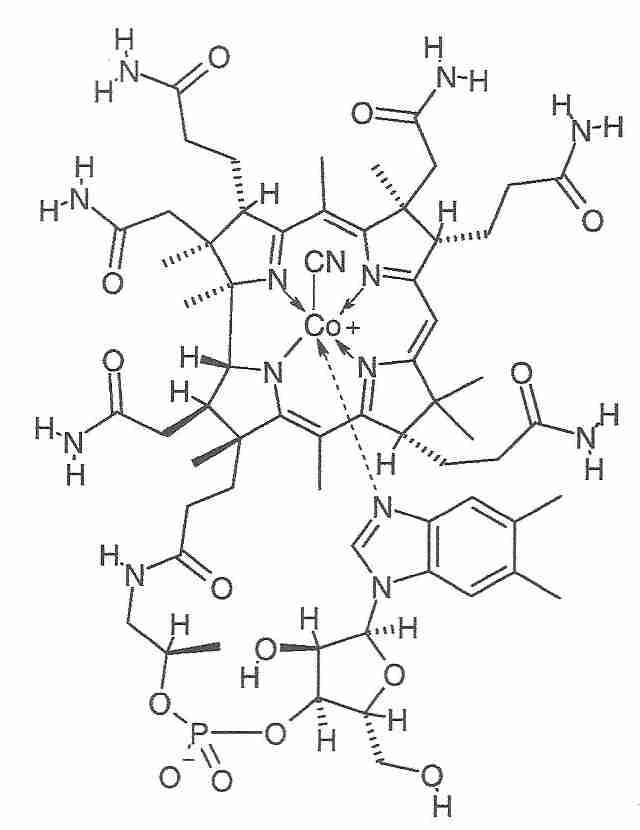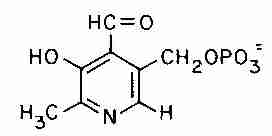
by Ben Best
RDA = Recommended Daily Allowance based on preventing acute nutrient deficiency disease conditions rather than based on amounts producing optimum health.
This webpage is not a comprehensive survey of the B Vitamins, nor is it much concerned with vitamin deficiency diseases. For a survey of B Vitamins see the Wikipedia entry on B Vitamins. The main focus of this webpage is on benefits and mechanisms, especially in relation to the Methionine Cycle.
Folic acid (folate) was so-named because it was discovered in the leafy vegetable spinach. Yeast, liver and fresh green vegetables are particularly good sources of folate. Cooking and food processing (such as canning) can destroy nearly all of the folic acid.
The form of folic acid that circulates in the blood stream is 5−MethylTetraHydroFolate (5−MTHF). 5−MTHF enhances endothelial cell (cells that line blood vessels walls) nitric oxide synthetase activity, increasing nitric oxide production and reducing production of damaging superoxide free radicals in blood vessels [CIRCULATION; Antoniades,C; 114(11):1193-1201 (2006)].

|
Folic acid is necessary for the methylation of uracil to thymine. Without this methylation, uracil rather than thymine may be incorporated into DNA — which can lead to chromosome breaks during DNA repair [PROCEEDINGS OF THE NATIONAL ACADEMY OF SCIENCES (USA); Blount,BC; 94(7):3290-3295 (1997)]. Supplementation with folic acid above the RDA levels minimizes chromosome breaks. Similarly, ingestion of less than 50% of the RDA of Vitamins B6 and B12 causes high levels of uracil incorporation in DNA and consequent chromosome breaks [MUTATION RESEARCH; Ames,BN; 475(1-2):7-20 (2001)].
Faulty DNA synthesis due to folic acid deficiency can initiate cancer. Inadequate gene silencing by SAMe methylation can similarly help initiate cancer. On the other hand, once cancer has begun, folic acid can assist the rapid DNA synthesis needed for cancer growth [AMERICAN JOURNAL OF CLINICAL NUTRITION; Ulrich,CM; 86(2):271-273 (2007)]
Rat hippocampal cells cultured in a folic acid deficient medium showed 8 times the rate of cell death as rat hippocampal cells cultured in a control medium, and cell death due to the amyloid-beta (Aß) peptide (Alzheimer's Disease) toxicity was more than double in the folic acid deficient medium. Amyloid transgenic mice showed similar effects on a folic acid deficient diet. Neuron death was attributed to impaired DNA repair [THE JOURNAL OF NEUROSCIENCE; Kruman,II; 22(5):1752-1762 (2002)]. An epidemiological study of elderly (mean age 74) humans showed that over a four year period high plasma homocysteine and low plasma folate were independently associated with an approximate doubling of risk for both Alzheimer's Disease and all-cause dementia [THE AMERICAN JOURNAL OF CLINICAL NUTRITION; 82(3):636-643 (2005)].
Pernicious anemia due to folic acid or Vitamin B12 deficiency can be completely cured by folic acid, but is more safely cured by Vitamin B12 because Vitamin B12 deficiencies can result in neuropathies, even when ample amounts of folic acid are present. Folic acid deficiency increases accumulation of homocysteine by reducing the conversion of homocysteine to methionine in the Methionine Cycle.
A double-blind study in which patients with vascular disease or diabetes were given a combination of folic acid along with Vitamins B6 & B12 or a placebo for 5 years showed a 20% lowering of homocysteine, but no reduction in cardiovascular death as compared to placebo [NEW ENGLAND JOURNAL OF MEDICINE; 354(15):1567-1577 (2006)]. A similar 40 month study of myocardial infarction patients showed a 27% reduction in plasma homocysteine, but no reduction (and possibly a small increase) in risk of cardiovascular death compared to placebo [NEW ENGLAND JOURNAL OF MEDICINE; 354(15):1578-1588 (2006)]. Vitamin B therapy may be interfering with methylation [CARDIOVASCULAR TOXICOLOGY; Joseph,J; 9(2):53-63 (2009)].

|
Vitamin B12 has a very large and complex chemical structure having cobalt as the central ion. Like folic acid, Vitamin B12 is particularly critical for DNA synthesis.
As with folic acid, Vitamin B12 is necessary for uracil to be methylated to thymine. Again, supplementation with Vitamin B12 above the RDA will minimize chromosome breakage. Homocysteine also accumulates with Vitamin B12 deficiency because Vitamin B12 is require to methylate homocysteine to methionine in the Methionine Cycle — making Vitamin B12 deficiency a risk factor for heart disease. When folic acid intake is adequate, homocysteine concentration becomes dependent upon Vitamin B12 intake [LANCET; Quinlivan,EP; 359:227-228 (2002)]. A four-year randomized, double-blind, placebo-controlled clinical trial supplementing stroke patients with folic acid 2 milligrams, Vitamin B6 25 milligrams, and Vitamin B12 500 micrograms showed significant reduction in plasma homocysteine, but no significant improvement in endothelial function [BMC CARDIOVASCULAR DISORDERS; Potter,K; 8:24 (2008)].
Hypothyroid patients have been found to have reduced serum Vitamin B12 and elevated homocysteine (a cardiovascular risk factor). Treatment with thyroid hormone has lowered serum homocysteine, but also lowered serum Vitamin B12 [ENDOCRINE JOURNAL; Orzechowska-Pawilojc,A; 54(3):471-476 (2007)].
Vitamin B12 regenerates folic acid, and adequate amounts of folic acid can completely eliminate the pernicious anemia associated with Vitamin B12 deficiency. Even in the presence of adequate folic acid, Vitamin B12 deficiency can result in neuropathies (myelin damage) leading to fatigue and depression. The neuropathies can affect the peripheral nerves, spinal cord, and cerebral cortex. The cerebral syndromes include memory loss, dementia and even psychosis [BRITISH MEDICAL BULLETIN; Weir,DG; 55(3):669-682 (1999)]. It is therefore dangerous to treat pernicious anemia with folic acid without assuring that there is no Vitamin B12 deficiency. Defective gastric intrinsic factor (a protein normally produced by parietal cells) can cause B12 deficiency because intrinic factor is essential for Vitamin B12 absorption from the gut into the bloodstream.
Autoimmune disorders are frequently associated with antibodies that destroy intrinsic factor and parietal cells [WORLD JOURNAL OF GASTROENTEROLOGY; Lahner,E; 15(41):5121-5128 (2009)]. Similarly, Vitamin B12 deficiency due to malabsorption may be secondary to Helicobacter pylori, a bacterium that is the most common cause of peptic ulcer, and which infects over half the adult population in developed countries [ARCHIVES OF INTERNAL MEDICINE; Kaptan,K; 160(9):1349-1353 (2000)].
Vitamin B12 has been shown to improve memory in studies with women [JOURNAL OF NUTRITION; Bryan,J; 132(6):1345-1356 (2002)]. A study of non-demented healthy elderly subjects who were not Vitamin B12-deficient showed that those with the lowest serum Vitamin B12 had the greatest brain volume loss over a 5-year period [NEUROLOGY;Vogiatzoglou,A; 71(11):826-832 (2008)].
The adult daily requirement for Vitamin B12 is 2 to 3 micrograms. The major dietary source of Vitamin B12 is meat (especially liver and shellfish) and dairy products. Lean meat contains about ten times the B12 as milk, and turkey contains about ten times the B12 as lean meat, but milk is a significant source of B12 because of high volume consumption [EXPERIMENTAL BIOLOGY AND MEDICINE; Watanabe,F; 232(10):1266-1274 (2007)]. In nature, only bacteria can synthesize Vitamin B12. Cyanocobalamin, a synthetic form of Vitamin B12, is converted to physiologically active forms of Vitamin B12 in the body. Vegans (persons eating no meat or dairy products) are frequently deficient in Vitamin B12, but symptoms can be slow to develop because Vitamin B12 is well-conserved by the body. A number of substances including metformin, nicotine, and potassium chloride supplements can block Vitamin B12 absorption.
| Pyridoxine | Pyridoxal | Pyridoxamine |
|---|---|---|
![[ Pyridoxine ]](pyridoxine.jpg)
|
![[ Pyridoxal ]](pyridoxal.jpg)
|
![[ Pyridoxamine ]](pyridoxamine.jpg)
|
| pyridoxal−5'−phosphate |
|---|

|
Vitamin B6 is a name applied to three related (enzymatically interconvertible) chemicals: pyridoxine, pyridoxal, and pyridoxamine. The primary biologically active form of the vitamin in human metabolism is a phosphate of pyridoxal: pyridoxal−5'−phosphate (PLP). PLP acts as a coenzyme in the synthesis of several neurotransmitters (serotonin, dopamine, norepinephrine, GABA), as a coenzyme for the synthesis of heme (a component of hemoglobin) and single-carbon metabolism involved in nucleic acid synthesis. PLP is a coenzyme in all transamination reactions.
Severe Vitamin B6 deficiency is rare, but mild
deficiency is common. Severe deficiency results in neurological
symptoms such as irritability, confusion, anemia,
inflammation, EEG abnormalities, and ulcers in the mouth. Milk
& meat are common sources, but some plant foods (bananas,
soybeans, peanut butter, orange juice and brans of wheat,
corn or rice) have Vitamin B6. The minimun
Recommended Daily Requirement (RDA) for adults is
1.3 milligrams — less for children, more for elderly
people as well as pregnant or breast-feeding women. The amount
of Vitamin B6 required increases with increased
dietary protein, probably because of the role of PLP in
amino acid metabolism. Two milligrams daily would be a safe
minimum for all adults. Some vegetarians should consider
taking supplements. Excessive pyridoxine can cause
painful sensory neuropathy so
100 milligrams daily is the recommended maximum for
adults (30 milligrams daily is the maximum for
young children).
| Anti-glycation comparison |
|---|

|
Homocysteine is an intermediate in metabolism of the amino acid methionine. Increased serum homocysteine is a risk factor for cardiovascular disease. Homocysteine levels can be reduced by conversion of homocysteine to the amino acid cysteine with Vitamin B6 (PLP) as a cofactor in the transsulfuration pathway leading from the Methionine Cycle. Or homocysteine can be converted back to methionine with folic acid & Vitamin B12 as cofactors as part of the Methionine Cycle.
Vitamin B6 deficiency is associated with immune system deficiency (reduced lymphocytes and interleukin−2 production) [AMERICAN JOURNAL OF CLINICAL NUTRITION; Meydani,SN; 53(5):1275-1280 (1991)]. Vitamin B6 has been shown to improve memory in studies with women [JOURNAL OF NUTRITION; Bryan,J; 132(6):1345-1356 (2002)]. PLP protects proteins from glycation [JOURNAL OF THE AMERICAN SOCIETY OF NEPHROLOGY; Nakamura,S; 16(1):144-150 (2005)] and PLP prevents lipid glycation more effectively than other common anti-glycation agents [JOURNAL OF LIPID RESEARCH; Higuchi,O; 47(5):964-974 (2006)]. Lipid glycation of LDL cholesterol increases the LDL oxidation associated with atherosclerosis [ATHEROSCLEROSIS, THROMBOSIS, AND VASCULAR BIOLOGY; Ravandi,A; 20(2):467-477 (2007)].
As with PLP, pyridoxamine also protects proteins against glycation and
damage from reactive carbonyl
species [BIOCHEMISTRY; Chetyrkin,SV; 47(3):997-1006 (2008)].
In combination with alpha-lipoic acid,
pyridoxamine improves glucose tolerance and insulin sensitivity in obese
Zucker rats (a model for obesity-associated insulin resistance) more than either
supplement alone [METABOLISM; Muellenbach,EA; 57(10):1465-1472 (2008)].
| NIACIN | NIACINAMIDE |
|---|---|
![[ NIACIN ]](niacin.jpg)
|
![[ NIACINAMIDE ]](niacinamide.jpg)
|
Nicotinic acid and its amide, niacinamide, are called vitamers, because both equivalently act as a vitamin. Niacin (a word derived from Nicotinic acid vitamin) is a generic term describing both vitamers together. Nicotinic acid is not directly converted to niacinamide, however, and many of the pharmacological properties of the two agents are very different.
Nicotinic acid can be synthesized from tryptophan, but tryptophan is an essential amino acid that cannot be synthesized. An intake of 60 milligrams of tryptophan might result in one milligram of nicotinic acid , because most tryptophan is used by the body for protein maintenance. Riboflavin (Vitamin B2) and pyridoxine (Vitamin B6) are essential cofactors in synthesizing nicotinic acid from tryptophan.
The niacin-deficiency disease pellagra was first recognized in 1735 by a Spanish physician among people living on corn (maise), a vegetable that is low in both niacin and tryptophan. It wasn't discovered until 1937 that niacin could cure pellagra. The RDA (Recommended Daily Allowance) of 13-20 mg per day is based on the amount required to prevent pellagra. High doses of nicotinic acid are often avoided because of the skin flushing & itching that it causes, although the flushing effect markedly diminishes within a week or two of repeated administration. Unlike nicotinic acid, niacinamide is not a vasodilator — niacinamide does not cause flushing.
According to the Framingham Heart Study, low HDL cholesterol resulted in a 4-fold increase in risk of cardiovascular or coronary artery disease death over a 12-year period. Low HDL cholesterol was seen to be a risk factor whether or not LDL cholesterol was elevated [VASCULAR HEALTH AND RISK MANAGEMENT; Vogt,A; 3(4):467-479 (2007)]. The risk of coronary heart diseased increased 2% in men and 3% in women for each 0.03 millimole/Liter (1 milligram/deciLiter) decrease in HDL cholesterol.
A dose of 1.5 to 3 grams of nicotinic acid per day can lower LDL cholesterol and elevate HDL cholesterol. Nicotinic acid increases apolipoprotein B (the primary lipoprotein of LDL cholesterol) degradation in the liver and inhibits triglyceride synthesis. By inhibiting liver removal of apolipoprotein a−1 (the primary lipoprotein of HDL cholesterol) from the circulation, nicotinic acid increases serum HDL half-life [AMERICAN JOURNAL OF CARDIOLOGY; Kamanna,VS; 101(Suppl):20B-26B (2008)]. Nicotinic acid decreases very low density lipoprotein-triglyceride (VLDL-TG) production [AMERICAN JOURNAL OF PHYSIOLOGY; Wang,W; 280(3):E540-E547 (2001)]. Nicotinic acid reportedly lowers the pro-inflammatory cardiovascular risk factor lipoprotein(a) [AMERICAN JOURNAL OF CARDIOLOGY; Scanu,AM; 101(Suppl):44B-47B (2008)].
Doses of sustained-release nicotinic acid in excess of 2 grams per day have been associated with liver toxicity, although some prescription sustained-release products are safe [AMERICAN JOURNAL OF CARDIOLOGY; Guyton,JR; 99(Suppl):22C-31C (2007)]. Nicotinic acid can increase insulin resistance, particularly in the elderly [ THE JOURNAL OF CLINICAL ENDOCRINOLOGY & METABOLISM; Chang,AM; 91(9):3303-3309 (2006)]. Slow-release niacin has been shown to increase HDL cholesterol in the range of 10%&nbps;(500 milligrams/day) to 30% (2,500 milligrams/day) [THE AMERICAN JOURNAL OF CARDIOLOGY; Goldberg,A; 85(9):1100-1105 (2000)]. Betaine (TMG) protects the liver against methyl depletion by excess nicotinic acid catabolism [AMERICAN JOURNAL OF CLINICAL NUTRITION; Craig,SAS; 80(3):539-549 (2004)].
The lipid-lowering actions of nicotinic acid are unrelated to its actions as a vitamin. Niacinamide has no lipid-lowering properties. Inositol hexanicotinate is being sold as "no-flush niacin", but there is insufficient evidence to conclude that it has lipid-lowering capacity.
Niacinamide forms the core of the nucleotide coenzyme NAD (Nicotinamide Adenine Dinucleotide) and its phosphate coenzyme NADP. NAD and NADP are essential for energy production, electron transport and antioxidant function through hydrogen acceptance (NADH & NADPH) and donation. NAD+ is required by the DNA-repair enzyme PARP — Poly (ADP-Ribose) Polymerase. Niacin doses equivalent in a human to 3 to 6 grams per day in rats have been shown to elevate PARP, NAD+ and reduce cancer susceptibility in a dose-dependent manner [JOURNAL OF NUTRITION; Boyonoski,N; 132(1):115-120 (2002)]. Niacinamide has been used to preserve beta-cells of the pancreas in type I diabetes, but in adult doses above 3 grams per day niacinamide has a potential for causing liver damage [DIABETOLOGIA; Knip,M; 43(11):1337-1345 (2000)].
An observational study of over 6,000 people 65 years of age and older found that compared to people in the lowest fifth of niacin intake, those with higher intake had between 20% to 50% the risk of getting Alzheimer's Disease. This result was after adjustment for age, sex, race, education, ApoE type and intake of vitamins E & C as well as beta-carotene. The effect was specific to niacin, as opposed to the other B vitamins [JOURNAL OF NEUROLOGY, NEUROSURGERY, AND PSYCHIATRY; Morris,MC; 75(8):1093-1099 (2004)].